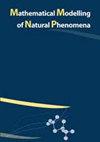A fractional diffusion model of CD8+T cells response to parasitic infection in the brain
IF 2.1
4区 数学
Q2 MATHEMATICAL & COMPUTATIONAL BIOLOGY
引用次数: 0
Abstract
Toxoplasma gondii (T. gondii) is a parasitic pathogen that causes serious brain diseases in fetuses and patients with immunodeficiency, particularly AIDS patients. In the field of immunology, a large number of studies have shown that effector CD8 + T cells respond to T. gondii infection in the brain tissue through controlling the proliferation of intracellular parasites and killing infected brain cells. These protective mechanisms do not occur without T cell movement and searching for infected cells, as a fundamental feature of the immune system. Following infection with a pathogen in a tissue, in their search for infected cells, CD8 + T cells can perform different stochastic searches, including Levy and Brownian random walks. Statistical analysis of CD8 + T cells in response to infected brain cells could be described by a Levy random walk., In this work, by considering a Levy distribution for the displacements, we propose a space fractional-order diffusion equation for the T cell density in the infected brain tissue. Furthermore, we derive a mathematical model representing CD8 + T cell response to infected brain cells. By solving the model equations numerically, we perform a comparison between Levy and Brownian search strategies.CD8+T细胞对脑内寄生虫感染反应的分数扩散模型
弓形虫(T.gondii)是一种寄生病原体,会导致胎儿和免疫缺陷患者,特别是艾滋病患者患上严重的脑部疾病。在免疫学领域,大量研究表明,效应CD8+T细胞通过控制细胞内寄生虫的增殖和杀死受感染的脑细胞,对脑组织中的弓形虫感染做出反应。如果没有T细胞的运动和寻找受感染的细胞,这些保护机制就不会发生,这是免疫系统的一个基本特征。在组织中感染病原体后,在寻找感染细胞时,CD8+T细胞可以进行不同的随机搜索,包括Levy和Brownian随机行走。CD8+T细胞对感染的脑细胞的反应的统计分析可以通过Levy随机游走来描述。,在这项工作中,通过考虑位移的Levy分布,我们提出了感染脑组织中T细胞密度的空间分数阶扩散方程。此外,我们推导了一个代表CD8+T细胞对受感染脑细胞反应的数学模型。通过数值求解模型方程,我们对Levy和Brownian搜索策略进行了比较。
本文章由计算机程序翻译,如有差异,请以英文原文为准。
求助全文
约1分钟内获得全文
求助全文
来源期刊

Mathematical Modelling of Natural Phenomena
MATHEMATICAL & COMPUTATIONAL BIOLOGY-MATHEMATICS, INTERDISCIPLINARY APPLICATIONS
CiteScore
5.20
自引率
0.00%
发文量
46
审稿时长
6-12 weeks
期刊介绍:
The Mathematical Modelling of Natural Phenomena (MMNP) is an international research journal, which publishes top-level original and review papers, short communications and proceedings on mathematical modelling in biology, medicine, chemistry, physics, and other areas. The scope of the journal is devoted to mathematical modelling with sufficiently advanced model, and the works studying mainly the existence and stability of stationary points of ODE systems are not considered. The scope of the journal also includes applied mathematics and mathematical analysis in the context of its applications to the real world problems. The journal is essentially functioning on the basis of topical issues representing active areas of research. Each topical issue has its own editorial board. The authors are invited to submit papers to the announced issues or to suggest new issues.
Journal publishes research articles and reviews within the whole field of mathematical modelling, and it will continue to provide information on the latest trends and developments in this ever-expanding subject.
 求助内容:
求助内容: 应助结果提醒方式:
应助结果提醒方式:


